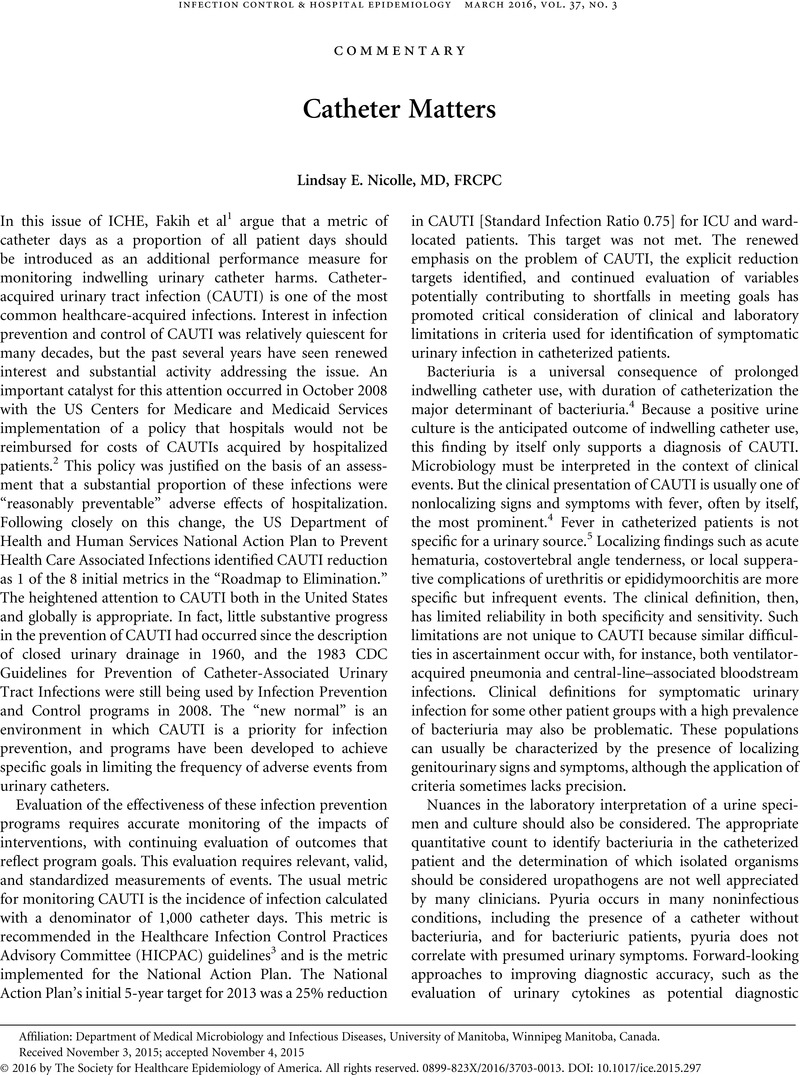No CrossRef data available.
Article contents
Catheter Matters
Published online by Cambridge University Press: 19 February 2016
Abstract
An abstract is not available for this content so a preview has been provided. Please use the Get access link above for information on how to access this content.

- Type
- Commentary
- Information
- Copyright
- © 2016 by The Society for Healthcare Epidemiology of America. All rights reserved
References
REFERENCES
1.
Fakih, MG, Gould, CV, Trautner, BW, et al. Beyond infection: device utilization ratio as a performance measure for urinary catheter harm. Infect Control Hosp Epidemiol
2015;37:327–333.Google Scholar
2.
Centers for Medicare and Medicaid Services (CMS) HHS. Medicare programs; changes to the hospital inpatient prospective payment systems and fiscal year 2008 rates. Fed Regist
2007;72:47129–48175.Google Scholar
3.
Gould, CV, Umsheid, CA, Agorwal, RK, Kuntz, G, Pegues, DA. Guideline for prevention of catheter-acquired urinary tract infections 2009. Infect Control Hosp Epidemiol
2010;31:319–326.Google Scholar
4.
Nicolle, LE. Urinary catheter-associated infection. Infect Dis Clinics N Amer
2012;26:13–28.Google Scholar
5.
Leekha, S, Preas, MA, Hebden, J. Association of National Healthcare Safety Network-defined catheter-associated urinary tract infections with alternate sources of fever. Infect Control Hosp Epidemiol
2015;36:1236–1238.Google Scholar
6.
Lo, E, Nicolle, LE, Coffin, SE, et al. Strategies to prevent catheter-associated urinary tract infections in acute care hospitals: 2014 update. Infect Control Hosp Epidemiol
2014;35:S32–S47.Google Scholar
7.
Meddings, J, Rogers, MA, Macy, M, Saint, S. Systematic review and meta-analysis: reminder systems to reduce catheter-associated urinary tract infections and urinary catheter use in hospitalized patients. Clin Infect Dis
2010;51:550–560.Google Scholar
8.
National Healthcare Safety Network. Surveillance for Urinary Tract Infections. Centers for Disease Control and Prevention website. http://www.cdc.gov/nhsn/acute-care-hospital/CAUTI/index.html. Accessed October 23, 2015.Google Scholar
9.
Oliver-Wright, M, Kharasch, M, Beaumont, JL, Peterson, LR, Robicsek, A. Reporting catheter-associated urinary tract infections: denominator matters. Infect Control Hosp Epidemiol
2011;32:635–640.Google Scholar
10.
Hollingsworth, JM, Rogers, MAM, Krein, SL, et al. Determining the noninfectious complications of indwelling urethral catheters. A systematic review and meta-analysis. Ann Intern Med
2013;159:401–410.Google Scholar


